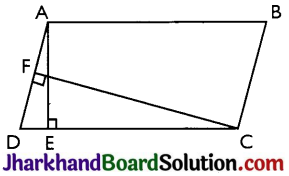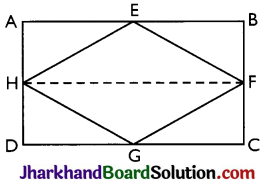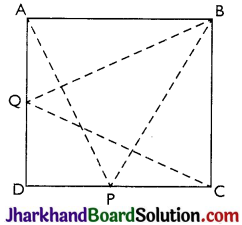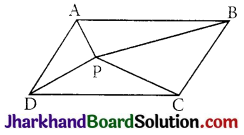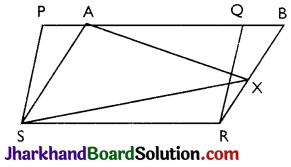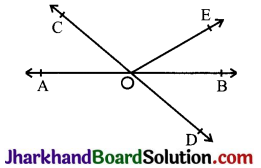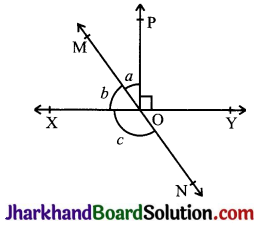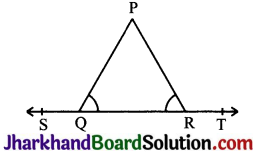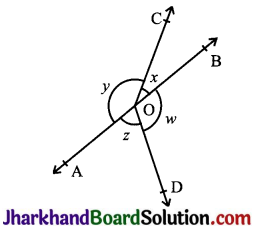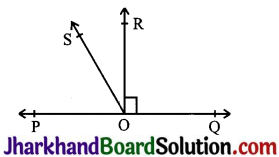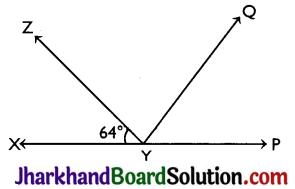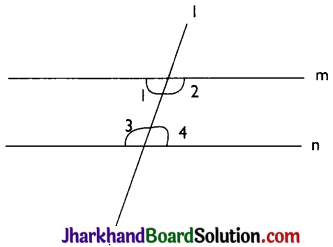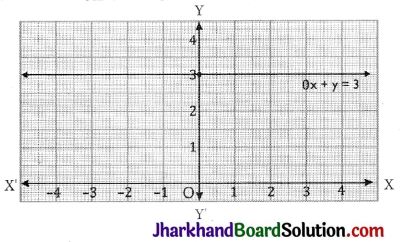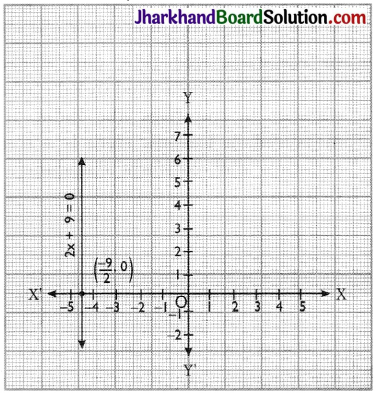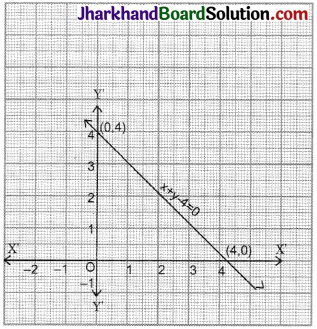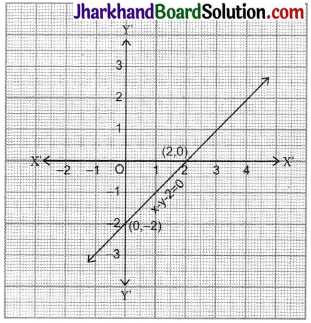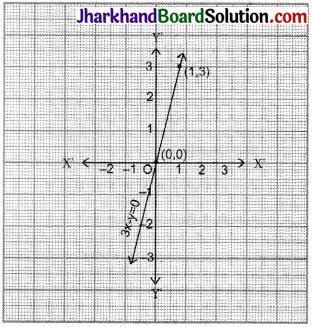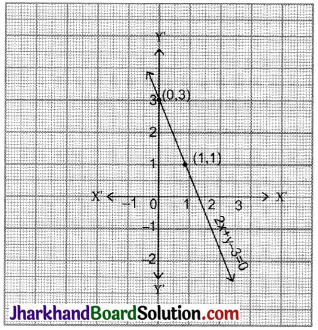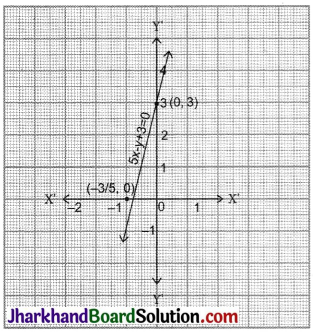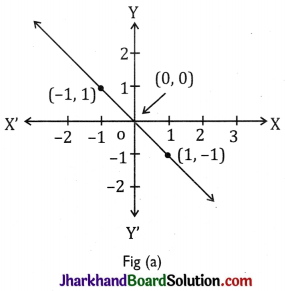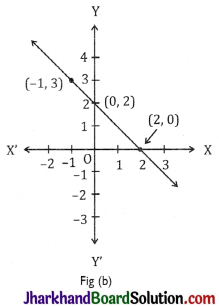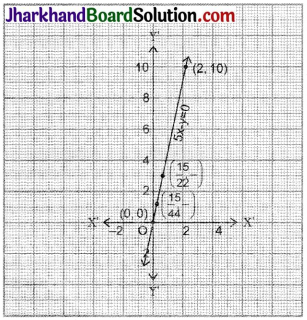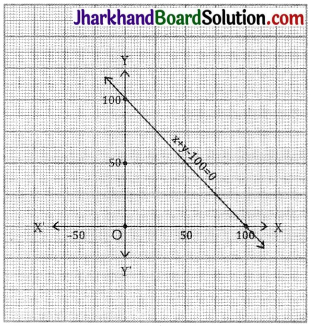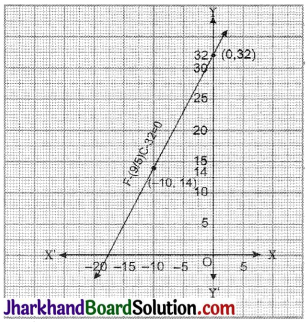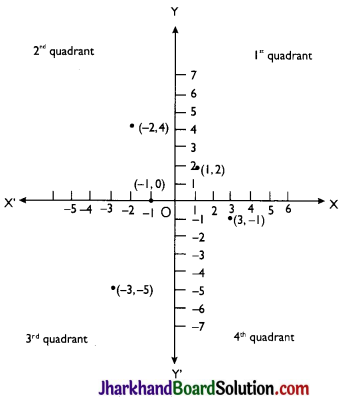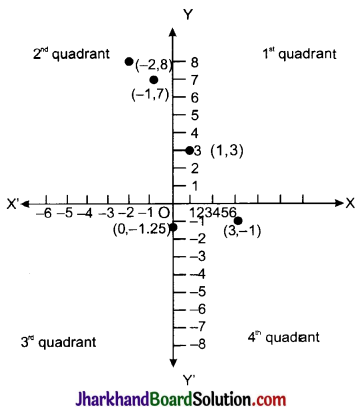Jharkhand Board JAC Class 10 Sanskrit Solutions रचना चित्राधारित वर्णनम् Questions and Answers, Notes Pdf.
JAC Board Class 10th Sanskrit Rachana चित्राधारित वर्णनम्
परिचय – ‘चित्राधारितवर्णनम्’ चित्रों के आधार पर लिखा जाने वाला अनुच्छेद या कथांश होता है अर्थात् चित्र-वर्णन में कोई भी सामान्य चित्र देकर उसका वर्णन करने को कहा जाता है। यह वर्णन मंजूषा में दिए गए शब्दों की सहायता से करना होता है। इस प्रकार इस प्रश्न का उत्तर लिखने के लिए शब्दों के वाक्य-प्रयोग का गहन और निरन्तर अभ्यास छात्रों द्वारा किया जाना चाहिए।
सामान्य निर्देश – चित्र-वर्णन करते समय निम्न बातों को ध्यान में रखना चाहिए –
- चित्र-वर्णन में एक ही भाव अथवा विचार प्रस्तुत करना चाहिए।
- भूमिका एवं उपसंहार नहीं होना चाहिए।
- विषय का प्रारम्भ शीघ्र ही करना चाहिए।
- वाक्य आपस में सम्बद्ध होने चाहिए।
- विशेषतः वाक्यों में रोचकता होनी चाहिए।
- भाषा सरल, सुबोध और प्रवाहयुक्त होनी चाहिए।
- वाक्य बहुत बड़े नहीं होने चाहिए।
- वाक्य अधिक छोटे भी नहीं होने चाहिए।
- चित्र का वर्णन मंजूषा में दिए गए शब्दों की सहायता से ही करना चाहिए।
- मंजूषा के शब्दों का प्रयोग चित्र के अनुसार ही करना चाहिए।
- चित्र को ध्यान में रखकर शब्दों के लिंग, वचन और पुरुष में परिवर्तन किया जा सकता है।
- चित्र-वर्णन में उसका केन्द्रीय भाव अथवा शिक्षा आवश्यकतानुसार प्रारम्भ या अन्त में देना चाहिए।
यहाँ पर चित्र-वर्णन के कुछ उदाहरण देकर उन्हें हल करके समझाया गया है। इनके गहन अध्ययन के द्वारा ही इनके लेखन में निपुणता प्राप्त की जा सकती है।
![]()
1. निम्नाङ्कितं चित्रं दृष्ट्वा प्रदत्तसंकेतपदानां साहाय्येन स्वविद्यालयस्य विषये षष्ठवाक्यानि लिखतु।
(निम्नांकित चित्र को देखकर दिये गये संकेत पदों की सहायता से अपने विद्यालय के विषय में छः वाक्य लिखिए।)
मञ्जूषा – ग्रामस्य मध्ये, विंशतिः, कक्षाः, षोडश अध्यापकाः, उद्यानम्, क्रीडाङ्गणम् मध्यान्तरे, क्रीडन्ति, अतीवसुन्दरः।
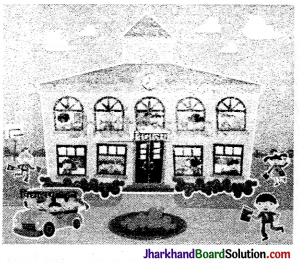
उत्तरम् :
1. अयम् विद्यालयः ग्रामस्य मध्ये स्थितः अस्ति। (यह विद्यालय गाँव के बीच में स्थित है।)
2. विद्यालये विंशति कक्षाः सन्ति। (विद्यालय में बीस कमरे हैं।)
3. अस्मिन् विद्यालये षोडश अध्यापकाः सन्ति। (इस विद्यालय में सोलह अध्यापक हैं।)
4. मम विद्यालस्य एकम् क्रीडाङ्गणम् अपि अस्ति। (मेरे विद्यालय का एक खेल मैदान भी है।)
5. बालकाः मध्यान्तरे क्रीडन्ति। (बालक मध्यावकाश में खेलते हैं।)
6. मम विद्यालयः अतीव सुन्दरः अस्ति। (मेरा विद्यालय अत्यन्त सुन्दर है।)
2. चित्रं दृष्ट्वा मञ्जूषायां प्रदत्तशब्दानां सहायतया अस्माकं जीवने वृक्षाणाम् उपयोगिता’ इति विषये षष्ठवाक्यानि लिखतु। (चित्र देखकर मन्जूषा में दिये गये शब्दों की सहायता से ‘हमारे जीवन में वृक्षों की उपयोगिता’ इस विषय पर छः वाक्य लिखिए।)
मञ्जूषा – अस्मिन् युगे, उपयोगिता, प्राणवायुं, पर्यावरणं, दृश्यते, फलानि, प्राप्नुम; छाया, काष्ठानि, खगाः, वृक्षाणां कर्तनं नैव।
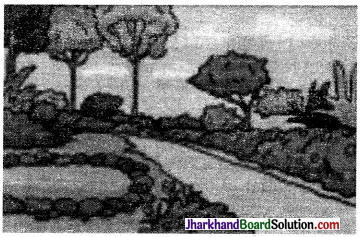
उत्तरम् :
1. अस्मिन् युगे वृक्षाणाम् अत्यधिकं महत्वं अस्ति। (इस युग में वृक्षों का अत्यधिक महत्व है।)
2. वृक्षाः अस्मभ्यम् प्राणवायुं प्रयच्छन्ति। (वृक्ष हमारे लिए प्राणवायु (आक्सीजन) देते हैं।)
3. वृक्षैः पर्यावरणं शुद्धं भवति। (वृक्षों द्वारा पर्यावरण शुद्ध होता है।)
4. वृक्षाः अस्मभ्यम् छाया यच्छन्ति। (वृक्ष हमारे लिए छाया देते हैं।)
5. खगाः वृक्षेषु तिष्ठन्ति। (पक्षी वृक्षों पर बैठते हैं।)
6. जनाः वृक्षाणां कर्तनं नैव कुर्यः। (मनुष्यों को वृक्ष नहीं काटना चाहिए।)
![]()
3. निम्नाङ्कितं चित्रं दृष्ट्वा प्रदत्तसंकेतपदैः षष्ठवाक्यानि लिखत। (नीचे अङ्कित चित्र देखकर दिये गये संकेत पदों से छ: वाक्य लिखिए।)
मञ्जूषा – राजमार्गस्य चित्रम्, वाहनानि, शीघ्रं गृहं, भारयुक्तवस्तूनि, प्रेषयितुं, शक्नुवन्ति, दुर्घटनाः सावधानेन, चालयामः, सम्भावनाः।

उत्तरम् :
1. इदम् राजमार्गस्य चित्रम् अस्ति। (यह सड़क (राजमार्ग) का चित्र है।)
2. राजमार्गे अनेकानि वाहनानि चलन्ति। (राजमार्ग पर अनेक वाहन चलते हैं।)
3. राजमार्गे वाहनेन वयं शीघ्रं गृहं गच्छामः। (राजमार्ग पर वाहन के द्वारा हम शीघ्र घर को जाते हैं।)
4. जनाः राजमार्गे वाहनैः भारयुक्तवस्तूनि नयन्ति। (मनुष्य राजमार्ग पर वाहनों द्वारा भारी वस्तुओं को ले जाते हैं।)
5. जनाः अनेकानि वस्तूनि प्रेषयितुं शक्नुवन्ति। (मनुष्य अनेक वस्तुएँ भेज सकते हैं।)
6. प्रतिदिनं राजमार्गे दुर्घटनाः भवन्ति। (प्रत्येक दिन राजमार्ग पर दुर्घटनाएँ होती हैं।)
4. अधः चित्रं दृष्ट्वा मञ्जूषायां प्रदत्तशब्दानां सहायतया ‘धेनु-महिमा’ इति विषयोपरि संस्कृत षष्ठवाक्यादि लिखत। (निम्न चित्र को देखकर मंजूषा में दिए शब्दों की सहायता से ‘धेनु-महिमा’ इस विषय पर संस्कृत में छः वाक्य लिखिए)
मञ्जूषा – दुग्धदातृषु, द्वौ शृंगौ, वसिष्ठ ऋषिः, घासं, अमृतोपमम्, स्वभावेन।
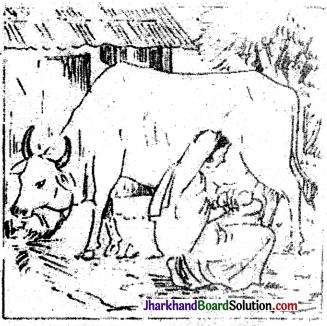
उत्तर :
(i) धेनुः अस्मभ्यं महदुपयोगी पशुः अस्तिः।।
(ii) अस्या महत्त्वं शास्त्रेषु वर्णितम्।
(ii) अमृतोपम् दुग्धदातृषु अस्मान् पोषयति।
(iv) धेनुः तृणानि स्वीकृत्य अमृतोपमं दुग्धं प्रयच्छति।
(v) अस्या गोमयेन अद्यापि ग्रामेषु गृहाणि लिम्प्यन्ते शुद्धयन्ते च।
(vi) अस्माभि सर्वेरपि सरलस्वभावेन धेनुः सर्वदा पूज्येत।
(गाय हमारे लिए बहुत उपयोगी पशु है। इसका महत्व शात्रों में वर्णित है। अमृत के समान दूध देकर हमारा पोषण करती है। गाय घास (तिनके) स्वीकार करके (खाकर) अमृत के समान दूध देती है। इसके गोबर से आज भी गाँवों में घरों को लीपकर शुद्ध किया जाता है। हमें भी सरल स्वभाव गाय की सदा पूजा करनी चाहिए।)
![]()
5. अधः चित्रं दृष्ट्वा मञ्जूषायां प्रदत्तशब्दानां सहायतया ‘काकस्य चातुर्यम्’ इति कथां लिखत। (निम्न चित्र को देखकर मंजूषा में दिए शब्दों की सहायता से ‘कौआ की चतुराई’ इस कहानी को लिखो।)
मञ्जूषा – एकः काकः, पिपासितः, घटे, न्यूनं जलं, प्रस्तर-खण्डान्, उपरि आगच्छति, पिपासा शान्ता।
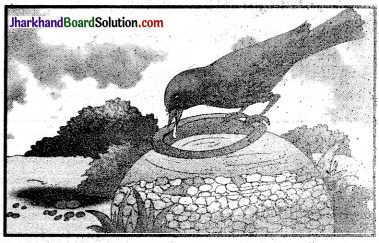
उत्तर :
(i) एकदा अत्यन्तपिपासितः एकः काकः जलं पातुम् इतस्ततः गच्छति।।
(ii) भ्रमता तेन एक: घटः दृष्टः।
(iii) घटे न्यूनं जलम् आसीत्।
(iv) सः मनसि विचार्य एकैकशः प्रस्तरखण्डान् आनयति घटे च पातयति।
(v) तेन जलं शनैः शनैः उपरि आगच्छति।
(vi) एवं तस्य पिपासा शान्ता भवति।
(एक बार अत्यन्त प्यासा एक कौआ जल पीने हेतु इधर-उधर जाता है। भ्रमण करते हुए उसने एक घड़ा देखा। घर में पानी कम था। वह मन में विचार कर एक-एक कंकड़ लाता है और घड़े में गिराता है। उससे पानी धीरे-धीरे ऊपर न जाता है। इस प्रकार उसकी प्यास शान्त हो जाती है।)
6. अधः चित्रं दृष्ट्वा मञ्जूषायां प्रदत्तशब्दानां सहायतया ‘पर्यावरण-प्रदूषणम्’ इति विषयोपरि संस्कृति षष्ठवाक्यानि लिखत। (निम्न चित्र को देखकर मंजूषा में दिए शब्दों की सहायता से ‘पर्यावरण-प्रदूषणम्’ इस विषय पर संस्कृत में छः वाक्य लिखिए।)
[मञ्जूषा – पर्यावरणम्, महानगरमध्ये, वाहनानि, धूमं मुञ्चति, दूषितं, ध्वनि-प्रदूषणं, वायुमण्डलं, शुचिः।]

उत्तर :
(i) इदानीं वायुमण्डलं भृशं प्रदूषितमस्ति।
(ii) अहर्निशं लौहचक्रस्य संचरणात् वाहनानां बाहुल्यात् च महानगरेषु संसरणं कठिनं वर्तते।
(iii) शकटीयानम् कज्जलमलिनं धूमं मुञ्चति।
(iv) महानगरमध्ये ध्वनि-प्रदूषण अपि कर्णौ स्फोटयति।
(v) शुचिः पर्यावरणे क्षणं सञ्चरणम् अपि लाभदायकं भवति।
(vi) पर्यावरणस्य संरक्षणम् एव प्रकृतेः आराधना।
(अब वायुमण्डल अत्यधिक प्रदूषित है। दिन-रात लौहचक्र के घूमने से तथा वाहनों के बहुतायत के कारण महानगरों में चलना कठिन है। मोटर गाड़ी काजल की तरह मलिन धुआँ छोड़ती हैं। महानगर के मध्य में ध्वनि प्रदूषण कानों को फोड़ता है। शुद्ध पर्यावरण में क्षणभर घूमना भी लाभदायक है। पर्यावरण का संरक्षण ही प्रकृति की आराधना है।)
![]()
7. अधोदत्तं चित्रं पश्यत। शब्दसूची-सहायतया चित्रम् आधृत्य संस्कृतेन षष्ठवाक्यानि उत्तरपुस्तिकायां लिखत। (नीचे दिए गए चित्र को देखिए। शब्द-सूची की सहायता से चित्र के आधार पर संस्कृत में छः वाक्य उत्तर
पुस्तिका में लिखिए।)
[मञ्जूषा – चित्रं, पितुः, राष्ट्रपिता, नाम, प्रदेशे, अभवत्, स्वतंत्रता-आन्दोलनेन, सत्यस्य, अहिंसायाः, अकरोत्, महापुरुषः]

उत्तर :
(i) इदं चित्रं महात्मागान्धीमहोदयस्य अस्ति।
(ii) गान्धीमहोदयस्य नाम मोहनदासकरमचन्दगान्धी आसीत्।
(iii) मोहनस्य पितुः नाम करमचन्दः मातुः नाम च पुतलीबाई आसीत्।
(iv) तस्य स्वतंत्रता – आन्दोलनेन भारतं स्वतंत्रम् अभवत्।
(v) सः सत्यस्य अहिंसायाः च उपदेशम् अकरोत्।
(vi) गांधी महोदयः अस्माकं राष्ट्रपिता अस्ति।
(यह चित्र महात्मा गाँधी महोदय का है। गाँधी महोदय का नाम मोहनदास करमचन्द गाँधी था। मोहन के पिता का नाम करमचन्द और माता का नाम पुतलीबाई था। उनके स्वतंत्रता आन्दोलन से भारत स्वतंत्र हो गया। उन्होंने सत्य और अहिंसा का उपदेश किया। गांधीजी हमारे राष्ट्रपिता हैं।)
8. अधः चित्रं दृष्ट्वा मञ्जूषायां प्रदत्तशब्दानां सहायतया द्वयोर्विवादे तृतीयस्य सिद्धिः’ इति कथां लिखत। (निम्न चित्र को देखकर मंजूषा में दिए शब्दों की सहायता से ‘द्वयोर्विवादे तृतीयस्य सिद्धिः’ कथा को लिखिए।)
मञ्जूषा – विवदमानौ, द्वौ बिडालौ, उद्याने गतवन्तौ, वानरः, विभक्तुं, एकां रोटिकां, लघुगुरुं, सर्वां खादति।
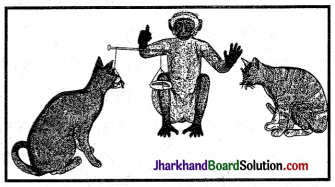
उत्तर :
(i) एकदा द्वौ बिडालौ कस्मिंश्चिद् गृहात् एकां रोटिकां अलभताम्।
(ii) तां विभक्तुं विवदमानौ एकस्मिन् उद्याने गतवन्तौ।
(iii) तौ विवदमानौ बिडालौ दृष्ट्वा एक: वानरः तत्र आगतः।
(iv) सः रोटिकां खादितुम् इच्छन् विभक्तुम् अकथयत्।
(v) वानरः रोटिकां लघुगुरुं करोति।
(vi) गुरुं पुनः लघु करोति। एवं शनैः शनैः सर्वां खादति।
(एक दिन दो बिलावों ने किसी घर से एक रोटी प्राप्त की। बाँटने के लिए झगड़ते हुए वे एक बाग में गये। उन झगड़ते हुए बिलावों को देखकर एक बन्दर वहाँ आ गया। उसने रोटी को खाने की इच्छा करते हुए बाँटने के लिए कहा। बन्दर रोटी को छोटी बड़ी कर देता है। बड़े को फिर छोटा कर देता है। इस प्रकार धीरे-धीरे सारी खा जाता है।
![]()
9. अधः प्रदत्तं चित्रम् आधृत्य मञ्जूषायां प्रदत्तशब्दानां सहायतया षष्ठ संस्कृतवाक्यानि उत्तरपुस्तिकायां लिखत। (नीचे दिए चित्र के आधार पर मंजूषा में दिए गए शब्दों की सहायता से संस्कृत में छः वाक्य उत्तर-पुस्तिका में लिखिए।)
मञ्जूषा – श्यामपट्टः, अध्यापकः, बालकाः, चित्रम्, काष्ठासनेषु, स्थिताः, प्रातः काले, उत्थापयन्ति।
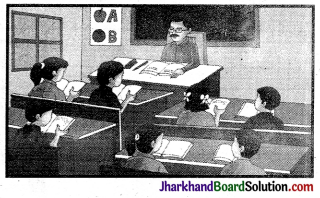
उत्तर :
(i) अस्मिन् चित्रे एकः अध्यापकः पाठयति।
(ii) कक्षे एकं चित्रं पुस्तकमंजूषा च अस्ति।
(iii) बालकाः पाठनसमये सावधानं भवन्ति।
(iv) अध्यापकस्य पार्वे श्यामपट्टः अस्ति सम्मुखे च पुस्तकम्।
(v) सर्वे बालकाः काष्ठासनेषु स्थिताः सन्ति।
(vi) बालकाः प्रात:काले उत्थापयन्ति। – (इस चित्र में एक अध्यापक पढ़ा रहा है। कमरे में एक चित्र और पुस्तक मंजूषा है। पढ़ने के समय बालक सावधान हो जाते हैं। अध्यापक के बगल में श्यामपट्ट है और सामने पुस्तक है। सभी बालक बेन्चों या कुर्सियों पर बैठे हैं। बालक प्रातःकाल उठते हैं।)
10. अधः प्रदत्तं चित्रम् आधृत्य मञ्जूषायां प्रदत्तशब्दसहायतया षष्ठ संस्कृतवाक्यानि लिखत। (नीचे दिए चित्र के आधार पर मंजूषा में दिए गए शब्दों की सहायता से छः संस्कृत के वाक्य लिखिए।)
मञ्जूषा – आश्रमपदम्, शिष्याः, साधवः, नदीतटे, स्नानम्, वटुकाः, शृण्वन्ति, उटजेषु, निवसन्ति, बहवः।
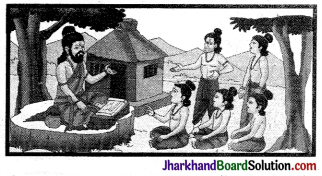
उत्तर :
(i) इदम् आश्रमपदम् अस्ति।
(ii) आश्रमः नदीतटे स्थितः।
(iii) अत्र वटुकाः गुरोः उपदेशं ध्यानेन शृण्वन्ति।
(iv) साधवः शिष्याः च नद्याः जले स्नानं कर्वन्ति।
(v) आश्रमे अनेका उटजाः सन्ति।
(vi) गुरुः, शिष्याः साधवः च उटजेषु निवसन्ति।
(यह आश्रम-स्थल है। आश्रम नदी के किनारे है। यहाँ विद्यार्थी गुरु के उपदेश को ध्यान से सुनते हैं। साधु और शिष्य नदी के जल में स्नान करते हैं। आश्रम में अनेक कुटियाँ हैं। गुरु, शिष्य और साधु कुटियों में रहते हैं।
![]()
अभ्यासः
11. चित्रं दृष्ट्वा शब्दसूचीसहायतया संस्कृते षष्ठवाक्यानि लिखत। (चित्र को देखकर शब्द-सूची की सहायता से संस्कृत में छः वाक्य लिखिए।) .
मञ्जूषा – वृक्षाः, मेधैः, कृषकः, महिला, कर्षति, क्षेत्रं, गगनं, आच्छादितम्, सिञ्चति, वपति, बीजं, अन्नं, आनयति।
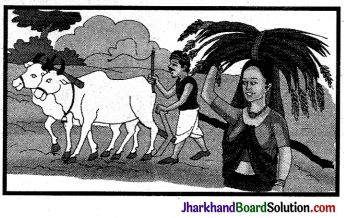
12. अधः स्थं चित्रमवलोक्य मञ्जूषायां प्रदत्तानां शब्दानां सहायतया ‘लुब्धकः कुक्कुरः’ इति कथां लिखत। (नीचे के चित्र को देखकर मंजूषा में दिए हुए शब्दों की सहायता से ‘लुब्धकः कुक्कुरः’ इस कहानी को लिखिए।)
[मञ्जूषा – प्रतिबिम्बम्, विचिन्त्य, लुब्धकः कुक्कुरः, अपरः कुक्कुरः, नद्यास्तटे, नदी प्रविश्य, मम पार्वे, न कर्तव्यः।]
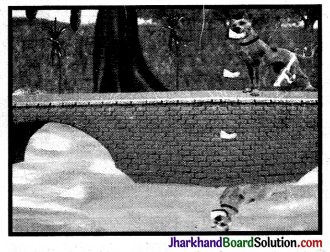
13. चित्रं दृष्ट्वा शब्दसूचीसहायतया संस्कृते षष्ठवाक्यानि लिखत। (चित्र को देखकर शब्द-सूची की सहायता से संस्कृत में छः वाक्य लिखिए।)
मञ्जूषा – नदी, रजकः, क्षालयति, वस्त्राणि, तरति, शुष्यन्ति, शिलापट्टके, पर्वतः, ग्रामे, गर्दभस्य, पृष्ठे, धृत्वा, नयति,
ग्रामीणाः, तम्, अन्नादिकं, प्रयच्छन्ति।
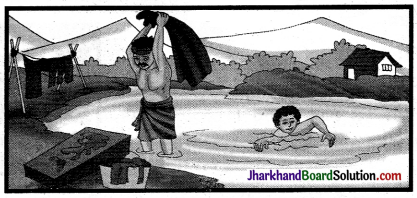
14. चित्रं दृष्ट्वा मञ्जूषायां प्रदत्तशब्दानां सहायतया षष्ठ संस्कृतवाक्यानि लिखत। (चित्र को देखकर मञ्जूषा में दिए शब्दों की सहायता से संस्कृत में छः वाक्य लिखिए।)
मञ्जूषा – श्यामपट्टः, गणितस्य, अध्यापिका, बालकः, लिखितम्, प्रश्नाः, घटिका यन्त्रानुसारम्, समयः, नववादनः, सा, लिखति, स्व, पुस्तिकासु, पृच्छति, उत्तरं ददाति।
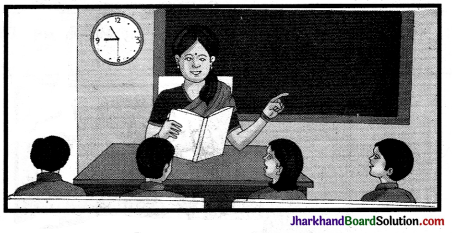
![]()
15. षष्ठषु संस्कृतवाक्येषु मञ्जूषाप्रदत्तपदसहायतया अधः दत्तं चित्रवर्णनं कुरुत। (छः संस्कृत वाक्यों में मञ्जूषा में दिए गए शब्दों की सहायता से नीचे दिए गए चित्र का वर्णन कीजिए।)
मञ्जूषा – एकः, चतस्रः शाखाः, हरितैः, पत्रैः, पूर्णः, शुकः, सारिका, कोकिला, चटका, काष्ठछेदकः, स्कन्धं, तिष्ठन्ति, मण्डलाकारे, परितः, गीतं, नृत्य, कक्षासु, गमिष्यन्ति।
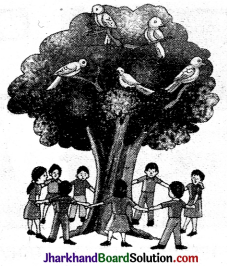
16. षष्ठषु संस्कृतवाक्येषु मञ्जूषापदसहायतया निम्नलिखितं चित्रवर्णनं कुरुत। (छ: संस्कृत वाक्यों में मञ्जूषा के शब्दों की सहायता से निम्नलिखित चित्र का वर्णन कीजिए।)
मञ्जूषा – जलौघः, गृहाणि, ग्रामस्य, जलनिमग्नानि, क्षेत्राणि, जलम्, अजशावकः, गृहस्य उपरिष्टात् तले, स्थिताः, दुःखिताः, नौकया, स्थानेषु, नयन्ति, वितरणं, भोजनं, वस्त्राणाम्।
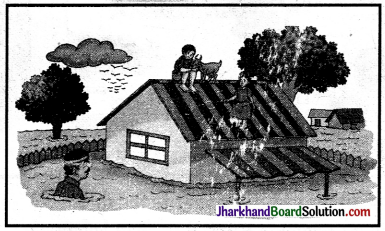
17. अधः चित्रं दृष्ट्वा मञ्जूषायां प्रदत्तशब्दानां सहायतया ‘सिंहमूषिकयोः’ कथां लिखत। (नीचे चित्र देखकर मंजूषा में दिये शब्दों की सहायता से ‘सिंहमूषिकयोः’ कथा को लिखिए।)
मञ्जूषा – तेन कारणेन, क्षमस्व माम्, एका मूषिका, गृहीतवान्, शयानस्य, पाशबद्धः, पाशं छित्त्वा, दयार्द्रः सिंहः।
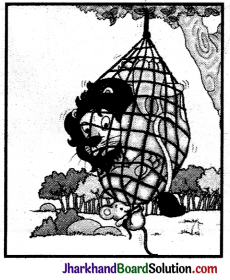
![]()
18. षष्ठ संस्कृतवाक्येषु मञ्जूषापदसहायतया अधः चित्रवर्णनं कुरुत। (छः संस्कृत वाक्यों में मञ्जूषा के शब्दों की सहायता से निम्न चित्र का वर्णन कीजिए।)
मञ्जूषा – परीक्षादिवसः, श्यामपट्टे, घटिकायन्त्रम्, भित्तौ, सपाद-अष्टवादनम्, परीक्षायाः, दृश्यते, यदा, घण्टाध्वनिः, अध्यापकमहोदयः, उत्तरपुस्तिकाः, प्रश्नपत्राणि वितरति, उत्तराणि।
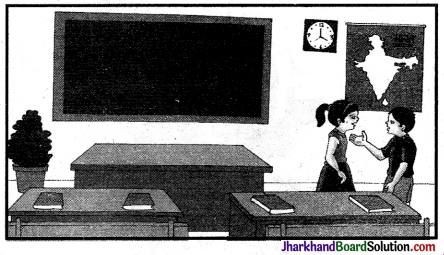
19. अधः स्थं चित्रम् अवलोक्य मञ्जूषादत्तपदानां सहायतया सोमशर्मपितुः कथाम्’ लिखत। (नीचे स्थित चित्र को देखकर मंजूषा में दिए हुए शब्दों की सहायता से ‘सोमशर्मपितुः कथाम्’ लिखिए।)
मञ्जूषा – भिक्षाटने, खट्वां निधाय, नागदन्ते, कृपणः ब्राह्मणः, धनमर्जित्वा, दुर्भिक्षकाले, येन भग्नः, अजाद्वयम्।
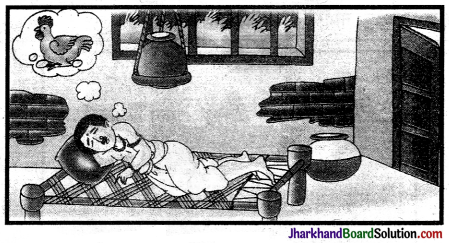
20. चित्रं दृष्ट्वा शब्दसूचीसहायतया संस्कृते षष्ठवाक्यानि लिखत।
(चित्र को देखकर शब्द-सूची की सहायता से संस्कृत में छ: वाक्य लिखिए।)
मञ्जूषा- सागरतटस्य, नारिकेलवृक्षौ, नौकाः, जलपोताः, सागरे, विशालः, तरंगयति, नौकया, जनाः, मत्स्याखेट, वहन्ति, शुक्तयः, शंखाः, मौक्तिकादयः, वस्तूनि प्राप्यन्ते।
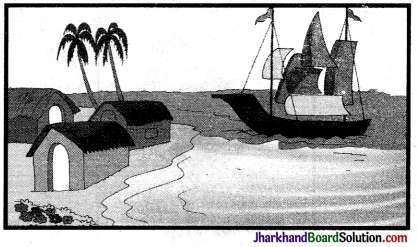
21. चित्रं दृष्ट्वा शब्दसूचीसहायतया संस्कृते षष्ठवाक्यानि लिखत। (चित्र को देखकर शब्द-सूची की सहायता से संस्कृत में छः वाक्य लिखिए।)
मञ्जूषा – छात्राः, शिक्षकाः, पुस्तकालयः, तरणतालः, कक्षाः, क्रीडाक्षेत्रं, परितः, उद्यानं, अनुशासनं, पठन्ति, विद्यालयः,
पुस्तकानि, अभ्यासः।
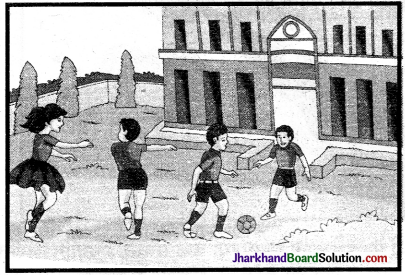
![]()
22. अधः चित्रं दृष्ट्वा मञ्जूषायां प्रदत्तपदानां सहायतया ‘स्वर्णाण्डदा कुक्कुटी’ इति कथां लिखत।
(निम्न चित्र को देखकर मंजूषा में दिए शब्दों की सहायता से ‘स्वर्णाण्डदा कुक्कुटी’ कहानी लिखिए।)
मञ्जूषा – महदुःखम्, व्यदारयत्, कर्त्तव्यः, एकः कृषकः, स्वर्णाण्डं, कुक्कुटपालनं, लुब्धः, ग्रहीतुमैच्छत्।।

23. अधः प्रदत्तं चित्रम् आधृत्य मञ्जूषायां प्रदत्तशब्दसहायतया षष्ठ संस्कृतवाक्यानि लिखत। (नीचे दिए गए चित्र के आधार पर मंजूषा में दिए शब्दों की सहायता से संस्कृत में छः वाक्य लिखिए।)
मञ्जूषा – उद्यानं, वृक्षाः, लताः, पुष्पाणि, तडागः, जलयंत्रं, उत्पतति, उद्यानपालकः, वसंतऋतौ, कोकिलः, कूजन्ति।

24. अधः चित्रं दृष्ट्वा मञ्जूषायां प्रदत्तपदानां सहायतया ‘गजपिपीलिकयोः कथाम्’ लिखत। (निम्न चित्र को देखकर मञ्जूषा में दिए शब्दों की सहायता से ‘गजपिपीलिकयोः कथाम्’ कथा लिखिए।)
[मञ्जूषा – एक: गजः, एका पिपीलिका, तुच्छं मत्वा, नो चेत्, शुण्डाग्रं, सत्ता, हेतुमिच्छति, मर्दयिष्यामि।]

![]()
25. चित्रं दृष्ट्वा मञ्जूषायां प्रदत्तशब्दानां सहायतया षष्ठ संस्कृतवाक्यानि लिखत।
(चित्र को देखकर मञ्जूषा में दिए गए शब्दों की सहायता से संस्कृत में छ: वाक्य लिखिए ।)
मञ्जूषा – वर्षा, विद्यालयः, मेघाः, छत्रं, कक्षा, मार्गेषु, प्रवहति, घोरगर्जनं, पुनः पुनः, वज्रपातः, सदृशः शब्दः, वर्षावकाशः।

अभ्यास-उत्तरमाला
11. (i) गगनं मेघैः आच्छादितम् । (ii) कृषक: हलं कर्षति । (iii) महिला क्षेत्रं गच्छति । (iv सन्ति । (v) कृषकः, क्षेत्र जलेन सिञ्चति । (vi) तदा सः क्षेत्रे बीजवपनं करोति।
(आकाश मेघों से ढका हुआ है । किसान हल जोतता है । औरत खेत पर जा रही है । बगल में वृक्ष हैं । किसान खेत को जल से सींचता है। फिर वह खेत में बीज बोता है।)
12. (i) एकस्मिन् ग्रामे एक: लुब्धः कुक्कुरः आसीत्। (ii) एकदा सः नद्याः तटे अगच्छत्। (iii) नद्याः जले प्रतिबिम्बं दृष्ट्वा सः मनसि अचिन्तयत् यद् अयम् अपरः कुक्कुरः। (iv) नदीं प्रविश्य अहम् अस्य कुक्कुरस्य अपि रोटिकाम् अपहरामि । (v) एवं मम पार्वे द्वे रोटिके भविष्यतः। (vi) यथा मुखं स्फारयति स्म तथैव तस्य रोटिका अपि जले पतति।
(एक गाँव में एक लोभी कुत्ता था। एक दिन वह नदी के किनारे गया। नदी के जल में परछाईं देखकर मन में सोचने लगा कि यह दूसरा कुत्ता है। नदी में घुसकर मैं इस कुत्ते की भी रोटी छीन लेता हूँ। इस प्रकार मेरे पास दो रोटियाँ हो जायेंगी। जैसे ही मुँह खोलता है वैसे ही रोटी भी जल में गिर जाती है।
13. (i) एका नदी प्रवहति पार्वे पर्वतः च अस्ति। (ii) एकः रजकः नद्याः जले शिलापट्टके वस्त्राणि क्षालयति। (iii) एकस्यां रज्ज्वां वस्त्राणि शुष्यन्ति । (iv) नद्यां बालकः तरति। (v) रजक: स्वच्छवस्त्राणि गर्दभपृष्ठे धृत्वा गृहं नयति। (vi) तदा सः वस्त्राणि ग्रामीणानां गृहेषु नयति।
![]()
14. अधः चित्रं दृष्ट्वा मञ्जूषायां प्रदत्तपदानां सहायतया गजपिपीलिकयोः कथाम्’ लिखत। (निम्न चित्र को देखकर मञ्जूषा में दिए शब्दों की सहायता से ‘गजपिपीलिकयोः कथाम्’ कथा लिखिए।)
मञ्जूषा – एक: गजः, एका पिपीलिका, तुच्छं मत्वा, नो चेत्, शुण्डाग्रं, सत्ता, हेतुमिच्छति, मर्दयिष्यामि।
15. चित्रं दृष्ट्वा मञ्जूषायां प्रदत्तशब्दानां सहायतया षष्ठ
(चित्र को देखकर मञ्जूषा में दिए गए शब्दों की सहायता से संस्कृत में छः वाक्य लिखिए।)
मञ्जूषा – वर्षा, विद्यालयः, मेघाः, छत्रं, कक्षा, मार्गेषु, प्रवहति, घोरगर्जनं, पुनः पुनः, वज्रपातः, सदृशः शब्दः, वर्षावकाशः।
अभ्यास-उत्तरमाला
11. (i) गगनं मेघैः आच्छादितम्। (ii) कृषक: हलं कर्षति। (iii) महिला क्षेत्रं गच्छति। (iv) पार्वे वृक्षाः सन्ति। (v) कृषकः, क्षेत्रं जलेन सिञ्चति। (vi) तदा सः क्षेत्रे बीजवपनं करोति।
(आकाश मेघों से ढका हुआ है। किसान हल जोतता है। औरत खेत पर जा रही है। बगल में वृक्ष हैं। किसान खेत को जल से सींचता है। फिर वह खेत में बीज बोता है।)
12. (i) एकस्मिन् ग्रामे एक: लुब्धः कुक्कुरः आसीत्। (ii) एकदा सः नद्याः तटे अगच्छत्। (iii) नद्याः जले प्रतिबिम्बं दृष्ट्वा सः मनसि अचिन्तयत् यद् अयम् अपरः कुक्कुरः। (iv) नदी प्रविश्य अहम् अस्य कुक्कुरस्य अपि रोटिकाम् अपहरामि। (v) एवं मम पार्वे द्वे रोटिके भविष्यतः। (vi) यथा मुखं स्फारयति स्म तथैव तस्य रोटिका अपि जले पतति।
(एक गाँव में एक लोभी कुत्ता था। एक दिन वह नदी के किनारे गया। नदी के जल में परछाईं देखकर मन में सोचने लगा कि यह दूसरा कुत्ता है। नदी में घुसकर मैं इस कुत्ते की भी रोटी छीन लेता हूँ। इस प्रकार मेरे पास दो रोटियाँ हो जायेंगी। जैसे ही मुँह खोलता है वैसे ही रोटी भी जल में गिर जाती है।
13. (i) एका नदी प्रवहति पार्वे पर्वतः च अस्ति। (ii) एकः रजकः नद्याः जले शिलापट्टके वस्त्राणि क्षालयति। (iii) एकस्यां रज्ज्वां वस्त्राणि शुष्यन्ति। (iv) नद्यां बालकः तरति। (v) रजक: स्वच्छवस्त्राणि गर्दभपृष्ठे धृत्वा गृहं नयति। (vi) तदा सः वस्त्राणि ग्रामीणानां गृहेषु नयति।
(एक नदी बह रही है और बगल में पहाड़ है। एक धोबी नदी के जल में शिलापट्ट पर वस्त्र धो रहा है। एक रस्सी पर कपड़े सूख रहे हैं। नदी में बालक तैर रहा है। धोबी स्वच्छ वस्त्रों को गधे की पीठ पर रखकर घर ले जाता है। तब वह वस्त्रों को ग्रामीणों के घरों पर ले जाता है।)
14. (i) एतस्मिन् चित्रे एका गणितस्य अध्यापिका गणितं पाठयति। (i) घटिकायन्त्रानुसारं नववादनः समयः अस्ति। (iii) बालकाः प्रश्नान् लेखितुम् उत्सुकाः सन्ति। (iv) अध्यापिकायाः पार्वे श्यामपट्टः अस्ति। (v) सा प्रश्नान्। श्यामपट्टे लिखति। (vi) बालकाः तान् प्रश्नान् स्व उत्तरपुस्तिकायां लिखन्ति।
(इस चित्र में गणित की एक अध्यापिका गणित पढ़ा रही है। घड़ी के अनुसार नौ बजे का समय है। बालक प्रश्न लिखने के लिए उत्सुक हैं। अध्यापिका की बगल में श्यामपट्ट है। वह प्रश्नों को श्यामपट्ट पर लिखती है। बालक उन प्रश्नों को अपनी उत्तरपुस्तिका में लिखते हैं।)
![]()
15. (i) एकः हरितैः पत्रैः पूर्णः वृक्षः तिष्ठति। (ii) वृक्षे चतस्रः शाखाः सन्ति। (iii) वृक्षस्य शाखाषु शुकः, सारिका, कोकिला, चटका, काष्ठछेदकः च पञ्च खगाः उपविशन्ति। (iv) बालकाः बालिकाश्च विशालं स्कन्धं परितः मण्डलाकारे तिष्ठन्ति। (v) बालक-बालिकाः समूहेषु तिष्ठन्ति। (vi) एका बालिका गीतं गायति।
(एक हरे पत्रों से भरा वृक्ष खड़ा है। वृक्ष में चार शाखाएँ हैं। वृक्ष की शाखाओं पर तोता, मैना, कोयल, गौरैया और कठफोड़ा पाँच पक्षी बैठे हैं। बालक और बालिकाएँ विशाल पेड़ के चारों ओर गोल घेरा बनाकर खड़े हैं। बालक-बालिकाएँ समूहों में बैठ जाते हैं। एक बालिका गीत गाती है।)
16. (i) ग्रामं परितः जलौघः। (ii) ग्रामस्य गृहाणि, क्षेत्राणि च जलनिमग्नानि सन्ति। (iii) सर्वत्र जलम् एव प्रवहति अन्यत् किमपि न दृश्यते। (iv) एका बालिका, एकः बालकः एकः अजशावकः च गृहस्य उपरिष्टात् तले स्थिताः अतीव दुःखिताः। (v) जनाः नौकाभिः तान् सुरक्षितस्थानेषु नयन्ति। (vi) नगरे जलौघपीडितेभ्यः शिविरम् अस्ति।
(गाँव के चारों ओर जल-समूह है। गाँव के घर और खेत जल में डूबे हुए हैं। सब जगह जल ही बह रहा है और कुछ भी दिखाई नहीं दे रहा है। एक लड़की, एक लड़का, एक बकरी का बच्चा घर के ऊपरी तल पर बैठे हुए अत्यन्त दुःखी हैं। लोग नावों से उनको सुरक्षित स्थानों पर ले जाते हैं। नगर में बाढ़ पीड़ितों के लिए शिविर हैं।)
17. (i) एकस्मिन् वने एका मूषिका एकः सिंहश्च निवसतः स्म। (ii) शयानस्य सिंहस्य उपरि मूषिका अभ्रमत् तेन कारणेन सिंह जागृतः। सः मूषिकां गृहीतवान्। (iii) मूषिका अवदत- ‘श्रीमन् ! अपराधं क्षमस्व मां मुञ्चतु। अहं ते (iv) दयाद्रः सिहः हसन् एव ताम् अत्यजत्। (v) एकदा वने सिहः पाशवद्धः अभवत्। (vi) मूषिका पाशं छित्वा सिंहः मुक्तम् अकरोत्।
(एक वन में एक चुहिया और एक सिंह रहते थे। सोते सिंह के ऊपर चुहिया घूमने लगी जिसके कारण शेर जाग गया। उसने चुहिया को पकड़ लिया। चुहिया बोली- ‘श्रीमन्! अपराध क्षमा करें। मुझे छोड़ दें। मैं तुम्हारा उपकार करूंगी।’ एक दिन वन में शेर जाल में फंस गया। चुहिया ने जाल काटकर सिंह को मुक्त कर दिया।)
![]()
18. (i) अद्य परीक्षादिवसः दृश्यते। (ii) भित्तौ घटिकायन्त्रं सपाद अष्टवादनं दर्शयति। (iii) परीक्षायाः समयः जातः। (iv) कक्षे श्यामपट्टे भारतवर्षस्य मानचित्रम् अपि दृश्यते। (v) यदा घण्टाध्वनिः भवति बालकाः कक्षासु प्रविशन्ति। (vi) अध्यापकमहोदयः उत्तरपुस्तिकानि प्रश्नपत्राणि च वितरति।
(आज परीक्षा दिवस दिखाई देता है। दीवार पर घड़ी सवा आठ बजा रही है। परीक्षा का समय हो गया है। कमरे में श्यामपट्ट पर भारत का मानचित्र भी दिखाई दे रहा है। जब घंटा ध्वनि होती है, छात्र कक्षा में प्रवेश करते हैं। अध्यापक महोदय उत्तरपुस्तिकाएँ और प्रश्नपत्र बाँटते हैं।)
19. (i) कस्मिंश्चित् नगरे एकः कृपणः ब्राह्मणः भिक्षाटनं कृत्वा उदरं पालयति स्म। (ii) भिक्षाटने सक्तून् प्राप्नोति, किञ्चित् खादति शेषान् घटे स्थापयति। (iii) पूर्णे घटे तं नागदन्ते अवलम्ब्य तस्य अधः खट्वां निधाय बद्धदृष्टिः अवलोकयति स्म। (iv) सः चिन्तयति यत् दुर्भिक्षकाले एतद् विक्रीय अजाद्वयं क्रेष्यामि। उत्तरोत्तरं व्यापारं कृत्वा धनम् अर्जित्वा विवाहं करिष्यामि। (v) मम पुत्रः भविष्यति यस्य नाम ‘सोमशर्मा’ इति करिष्यामि। (vi) क्रुद्धः अहं पत्नी पादेन ताडयिष्यामि एवं चिन्तयन् असौ पादेन घटम् अताडयत् येन भग्नः।
(किसी नगर में एक कंजस ब्राह्मण भिक्षाटन करके पेट पालता था। भिक्षा में सत्त प्राप्त करता है. कछ खा लेता है. शेष को घड़े में रख देती हैं। घड़ा पूरा होने पर खूटी से लटकाकर उसके नीचे खाट डालकर टकटकी लगाये देखता रहता था। वह सोचता है कि अकाल में इसे बेचकर दो बकरियाँ खरीदूँगा। उत्तरोत्तर व्यापार करके धन अर्जित करूँगा और विवाह करूँगा। मेरा बेटा होगा जिसका नाम ‘सोम शर्मा’ रखूगा। नाराज हुआ मैं पत्नी की लात मारूँगा। ऐसा सोचते हुए उसने पैर से घड़े में लात मारी, जिससे टूटा हुआ घड़ा नीचे गिर गया।)
20. (i) इदं विशालसागरतटस्य चित्रम् अस्ति। (ii)अत्र विशालसागरः तरंगयति। (iii) अत्र द्वे पर्णकुटीरे स्तः। (iv) सागरतटे नारिकेलवृक्षौ स्तः। (v) समुद्रे नौकाः जलपोताः च सन्ति। (vi) नौकया जनाः मत्स्याखेटं कुर्वन्ति।
(यह सागर तट का चित्र है। यहाँ विशाल सागर तरंगित हो रहा है। यहाँ दो पर्णकुटियाँ हैं। सागर तट पर नारियल के दो वृक्ष हैं। समुद्र में नावें और जलयान हैं। नाव से लोग मछलियाँ पकड़ते हैं।)
21. (i) अद्य बालदिवसः अस्ति। (ii) विद्यालयस्य एकस्मिन् भागे बालभवनम् अस्ति। (iii) क्रीडाङ्गणे छात्राः कन्दुकेन क्रीडन्ति, धावन्ति आनन्दं च अनुभवन्ति। (iv) बालदिवसे सर्वे छात्राः आनन्दम् अनुभवन्ति। (v) बालदिवसे क्रीडाप्रतियोगिता वाद-विवादप्रतियोगिता च भवतः। (vi) बालदिवसे बालसभायाः आयोजनं भवति।
(आज बालदिवस है। विद्यालय के एक भाग में बालभवन है। खेल के मैदान में छात्र गेंद से खेलते हैं, दौड़ते हैं और आनन्द का अनुभव करते हैं। बालदिवस पर सभी छात्र आनन्द का अनुभव करते हैं। बालदिवस पर खेल प्रतियोगिता और वाद-विवाद प्रतियोगिता होती हैं। बालदिवस पर बाल-सभा का आयोजन होता है।)
![]()
22. (i) एकस्मिन् ग्रामे एकः लुब्धः कृषकः प्रतिवसति स्म। (ii) तस्य कुक्कुटेषु एका कुक्कुटी नित्यमेक स्वर्णाण्डं प्रसूते स्म। (iii) सां एकदा एव सर्वाणि अण्डानि ग्रहीतुमैच्छत्। (iv) सः तस्य उदरं व्यदारयत्। (v) परञ्च नासीत् तत्र एकमपि अण्डम्। (vi) कृषक: महददुःखमनुभवन् सपश्चात्तापम् अवदत-‘अति लोभो न कर्तव्यः।’
(व में एक लोभी किसान रहता था। उसके मुर्गों में एक मुर्गी नित्य एक सोने का अण्डा देती थी। वह एक दिन ही सारे अण्डे प्राप्त करना चाहता था। उसने उसका पेट फाड़ डाला। परन्तु वहाँ एक भी अण्डा नहीं था। किसान बहुत दुःख का अनुभव करता हुआ पश्चात्ताप के साथ बोला-“अधिक लोभ नहीं करना चाहिए।”)
23. (i) इदम् एकं उद्यानम् अस्ति। (ii) उद्याने अनेके वृक्षाः पादपाः लताः च सन्ति। (iii) पादपेषु पुष्पाणि विकसन्ति। (iv) अत्र एकः तडागः अस्ति। (v) उद्याने एक जलयन्त्रम् अस्ति। (vi) जलयन्त्रात् जलं उत्पतति।
(यह एक बाग है। उद्यान में अनेक पेड़, पौधे और बेल हैं। पौधों में फूल खिल रहे हैं। यहाँ एक तालाब है। बाग में एक फब्बारा है। फब्बारे से जल उछलता है।)
24. (i) एकदा एका पिपीलिका गच्छति स्म। (ii) मार्गे एकः गजः तां दृष्ट्वा अकथयत्- “रे पिपीलिके ! मम मार्गात् दूरी भव नो चेत् अहं त्वां मर्दयिष्यामि।” (iii) पिपीलिका कथयति – “भो गज ! मां तुच्छं मत्वा कथं मर्दयसि ?” (iv) एकदा सैव पिपीलिका गजस्य शुण्डाग्रं प्राविशत् तम् अदशत् च। (v) अतीव पीडितः गज क्रन्दति-“न जाने कः जीव: मम प्राणान् हर्तुम् इच्छति?” (vi) पिपीलिका अवदत्-“अहं सैव पिपीलिका यांत्वं तुच्छजीवं मन्यसे। संसारे कोऽपि न तुच्छ: न च उच्चः।
(एक बार एक चींटी जा रही थी। मार्ग में एक हाथी ने उसे देखकर कहा- ‘अरे चींटी मेरे रास्ते से दूर हो जा, नहीं तो मैं तुम्हें कुचल दूँगा।’ चींटी कहती है – ‘अरे हाथी, मुझे तुच्छ मानकर कैसे मर्दन करता है? ‘ एक दिन वह चींटी हाथी की सँड़ में घुस गई और उसे काट लिया। अत्यन्त पीड़ित हाथी कहता है- ‘न जाने कौन जीव मेरे प्राण हरण करना चाहता है।’ चींटी ने कहा-“मैं वही चींटी हूँ जिसको तू तुच्छ जीव मानता है। संसार में कोई तुच्छ या उच्च नहीं होता।”)
![]()
25. (i) अस्मिन् चित्रे अनवरतवेगेन वर्षा भवति अतः गगनं मेधैः आच्छन्नमस्ति। (ii) समीपमेव एकस्य विद्यालयस्य भवनम् अस्ति। (iii) विद्यालयाद् बहिरेका महिला द्वौ भगिनी-भ्रातरौ च छत्रं धारयतः। (iv) कक्षाकक्षेषु छात्राः न सन्ति। (v) वर्षासमये मार्गेषु जलं वहति। (vi) मेघाः पुनः-पुनः घोरं गर्जनं कुर्वन्ति।
(इस चित्र में लगातार वर्षा हो रही है अत: आकाश मेघों से ढका हुआ है। पास में ही एक विद्यालय भवन है। विद्यालय से बाहर एक महिला और दो भाई-बहिन छाता धारण किए हैं। कक्षा कक्षों में छात्र नहीं हैं। वर्षा के समय मार्गों पर जल बहता है। बादल बार-बार गर्जना करते हैं।)
